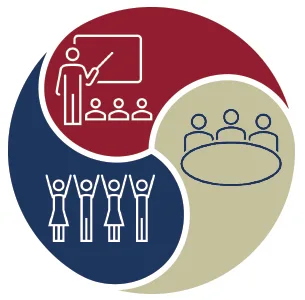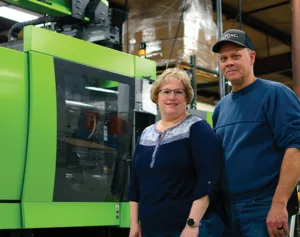Year after year participants in Enterprise Minnesota’s State of Manufacturing® (SOM) survey rank attracting and retaining quality workers among their top concerns. The same respondents also say hiring new employees is the top driver of new growth for their companies.
Combine these two dynamics — companies need great talent to drive growth, and there is a limited pool of workers — and it makes sense that attracting and retaining high performers is ranked among the survey’s top concerns.
It also makes sense that respondents want their companies to be known for a great work environment. That’s a good sign; it means employers recognize the problems of the worker shortage, and they are focused on what to do about it.
There’s more positive news: This is a perfect moment to review workplace trends, hiring approaches and employment practices. It turns out the best strategies for attracting and retaining great employees are also great for business overall.
The first step in making the most of this moment is understanding three key human resources trends for 2023. These shifts provide the foundation for implementing six drivers of retention that are critical to keeping employees satisfied and committed to their jobs.

Reshaping workplace learning
Disengaged employees are at the highest risk for leaving, but for those who are engaged, it is precisely the opposite. It takes more than a 20% pay increase to lure employees away from a manager who is actively engaging them.
That means it is critical to help managers develop the leadership skills to engage their team members. In the wake of the “Great Resignation” — the exit of record numbers of employees after the COVID-19 pandemic — the leadership pipeline for many employers is likely to be weak.
Manufacturers might have fewer employees ready to step in as leaders, or if they are ready, those leaders might have very little manufacturing experience. Or there might be high-performing employees with excellent manufacturing skills but little leadership experience or training. This is the time to assess those gaps: Good leaders engage employees, and engaged employees don’t leave.
Workplace learning must also include technical and essential skill development. Employees who see a clear path for skill development and career advancement are more likely to remain with an employer. On the technical side this means training to maximize the benefits of new technologies and tools. Essential skills include methods for effective communication.
Changing expectations between employees and employers
Persistent low unemployment has helped change the relationship between employees and employers. In this new landscape, employers elevate their employees and strive to serve them. In turn, these individuals feel so valued that they provide excellent service to clients and customers, which results in the achievement of organizational goals.
Employee well-being — mental, physical, and financial — lies at the heart of an employee-focused workplace. Financial health is a newer and important part of this package. Helping employees relieve stress, possibly through financial coaching or improved benefits education, allows them to bring their whole self to the organization.
The changing relationship between employees and employers has also affected employee expectations about flexibility and scheduling. A recent survey by LinkedIn showed that 14% of all job openings posted were for remote positions. But 52% of all applicants applied for those remote jobs. While few manufacturers can offer remote work, they can offer the next best thing: employee-approved shift flexibility. This might include four/tens, part-time work, or job sharing, all with full benefits. Whatever the arrangement, employees need a voice.
Creating a culture of belonging
Polling indicates that two-thirds of workers admit the pandemic dramatically shifted their priorities in life and work. In addition, research published in 2022 by management consulting firm McKinsey & Company shows 82% of employees say it is important for the organization where they work to have a clear purpose.
A meaningful organization is one where team members feel valued for their contributions at work, are supported in their daily efforts, and encouraged in their career development. Importantly, they are proud of their employer’s mission and culture.
Employers can assess progress toward creating a culture of belonging by asking how employees feel about their work. Are their needs being met? What do they get out of their job? What does management give to their team, their career, and their life? What do they give to the organization? Do they feel like they belong?
A culture of belonging rewards teamwork, and its leaders prioritize the growth of the team. Creating this type of culture attracts employees across generations, from millennials and Gen Z workers who prioritize values and purpose to retirement-aged employees who might decide to work longer if they feel their contributions matter.

Drivers of retention
With an understanding of these workplace trends, we can dig into the six key drivers of retention.
Recruitment and hiring
Companies aiming to improve recruiting and hiring practices should first determine their retention and turnover rates. The retention rate shows the stability of the workforce, but it does not track the departures of employees who joined and subsequently left during the period being tracked.
Turnover measures the number of separations during that period, and if leaders dig down into reasons for those departures, they can better address underlying causes. Considering these two figures together helps companies determine future hiring needs, and also reveals weaknesses in HR practices that might lead to turnover.
To expand candidate pools, I encourage employers to target historically underrepresented groups and re-qualify what “skilled workforce” means.
Consider an underrepresented group of potential employees, such as those with disabilities. Data shows 11% of Minnesotans have a disability, and the unemployment rate for that population is much higher than the general population. This might be an excellent and productive area for targeted recruiting.
Employers can also attract additional candidates by implementing skills-based hiring that only requires the educational credentials needed for the job. A company I am currently working with made a conscious decision to train welders. There’s no experience needed other than technical aptitude and some essential skills. When companies redefine what a skilled workforce is, and have training systems in place, they can access a greater pool of talent.
Finally, manufacturers must be intentional about onboarding and helping employees through the hiring process. No company can afford to show up on social media because they aren’t getting back to candidates or have a really long interview process. It’s critical to focus on the right people at the right time and move quickly.
Pay and benefits
The employee benefits package is essential to attract and retain talent. The goal is to build a total reward system of pay and benefits that is clear, logical, transparent, and factored around performance.
Consider employee input when constructing pay and benefits packages. Use survey data and information from benefit brokers about industry standards to find out what employees need and want.
And lastly, educate, educate, educate. Let employees know what benefits are available, and walk them through how to use them. Companies and their HR departments work hard to build great benefits packages, and they should give employees the information they need to take full advantage of them.
Belonging and empowerment
Make equitable opportunity a core value. At a company I worked with in the past, we reviewed our benefits, specifically self-development opportunities. In this case, we looked at who was participating in a tuition payment program.
Because participants paid in advance and received reimbursement, the higher-paid employees took advantage of the benefit, but lower-wage workers didn’t. Those workers wanted to participate, but the up-front payment was a barrier for them.
We started paying for tuition in advance, and participants agreed to stay with the company for a certain amount of time after they had received the benefit. The result? More employees who wanted to enhance their qualifications were able to access the benefit. Plus, they felt a sense of belonging and empowerment.
Companies can also enhance the feeling of belonging by adopting systems that give everyone a voice, without fear of retaliation. Enable workers to contribute to decisions about the workplace, such as how work is performed and assessed. More broadly, seek their input on the direction of the company.
Organizational culture
Studies show that a toxic culture is 10 times more likely to drive away employees than compensation. If team members feel uncomfortable within the organization, chances are good they will not stay long.
On the other hand, a healthy workplace culture can play a major role in staff development and retention. Leaders can create a positive culture by demonstrating that all workers are respected and valued. They also need to communicate how workers are contributing meaningfully to the organization.
Surveys that assess how employees feel about the culture are especially useful. Enterprise Minnesota uses Gallup’s Engagement Hierarchy to determine how employees and managers are feeling about workplace culture and their role in it.
Job security and working conditions
Employers need to provide a safe, healthy, and accessible workplace that balances work/personal life and offers job security. They should ensure adequate staffing levels and remain vigilant about health and safety.
One area of concern is use of a contingent workforce. Temporary and contract workers should be used only to accommodate short-term needs. A workplace with a lot of long-term temporary employees undermines the sense of job security companies need for retention.
It is also important to assess and create flexible schedules that are adequate to cover needs but also predictable. I applaud a client I worked with who kept overtime to a minimum, not just for financial reasons, but also for workforce planning. There were a number of parents working there, and if we asked them to work overtime, childcare became a problem.
With adequate staffing and predictable but flexible scheduling, companies can boost that last-but-not-least factor: safety. Ensuring safe work environments for employees must be a top priority.
Learning and development
As noted, one of the key trends of 2023 is reshaping workplace learning. Investing in employee development sends a strong message about the value of education and employee growth. A good learning and development strategy will help employees at all levels master the skills they need to do their jobs well and position them for advancement in the company.
This means creating formal policies for managers that ensure employees have development opportunities. Managers often do such a good job attending to “daily fires” that they don’t have time to acquire the skills and experience to continue growing.
Regardless of their role in the company, it is important to use an individual approach to unlock the knowledge and talent of each employee. Also, be sure to document each of their strengths so there is a starting place and a benchmark for progress.
Even if employers aren’t having conversations about advancement, employees are considering those issues on their own, and they are likely to look outside of the organization for their next job. Without those conversations about what they want in terms of education, and work aspirations, companies will continue to experience that talent shortage because potential workers will look for an employer who nurtures their talents and lays out a path for professional growth.
The bottom line for manufacturers is that they can tackle the worker shortage. Knowing key trends in workplace dynamics and implementing initiatives surrounding the six drivers of retention can transform an employer’s efforts to attract and retain the best employees.



